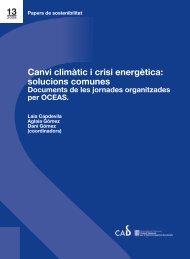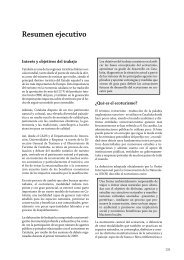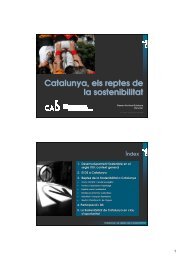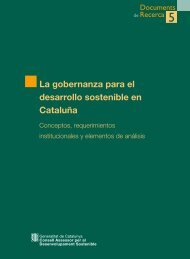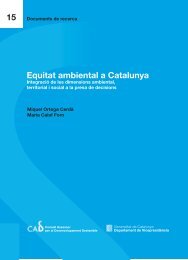Estratègies per al desenvolupament sostenible - Generalitat de ...
Estratègies per al desenvolupament sostenible - Generalitat de ...
Estratègies per al desenvolupament sostenible - Generalitat de ...
You also want an ePaper? Increase the reach of your titles
YUMPU automatically turns print PDFs into web optimized ePapers that Google loves.
Organized into a consistent framework. The pressure–state–response frameworkhas been used, <strong>al</strong>though it is better suited to environment<strong>al</strong> monitoring than morecomprehensive sustainable <strong>de</strong>velopment needs.Assessment should commence from the outset of a strategy process to establisha baseline. But, as monitoring and ev<strong>al</strong>uation are integr<strong>al</strong> to a continuous improvementapproach to <strong>de</strong>cision making, they should be regular and integrated activities ratherthan sporadic and separate events. The benefit of regular assessment is that itencourages participants to rethink priorities, reset objectives and rechart their courseof action. It keeps the strategy working as a system, rather than an (increasingly outof date) master plan.The pressure–state–response framework is an approach for linking a greatnumber of variables that need to be monitored to assess the state of theenvironment. As such, it has both utility and limits – limits that are beingstretched with its more recent application to the even more complex issue ofthe state of sustainable <strong>de</strong>velopment. The framework follows a holisticcause–effect–soci<strong>al</strong> response logic. Sustainability indicators are selected,based on variables, which sign<strong>al</strong> pressure, state and response:The pressure that society puts on the environment; for example in the formof <strong>de</strong>mands on resources (leading to resource <strong>de</strong>pletion) and <strong>de</strong>mands onecologic<strong>al</strong> processes (leading to pollution). Pressure indicators are basedon measurements or on mo<strong>de</strong>l-based estimates of actu<strong>al</strong> behaviour.The resulting state of the environment (especi<strong>al</strong>ly the incurred changes)compared with <strong>de</strong>sirable (sustainable) states. State indicators cover themajor characteristics of natur<strong>al</strong>, physic<strong>al</strong>, financi<strong>al</strong>, soci<strong>al</strong> and human capit<strong>al</strong>assets, individu<strong>al</strong>ly or in a combined manner.The response mainly in the form of politic<strong>al</strong> and societ<strong>al</strong> <strong>de</strong>cisions, measuresand policies. Response indicators measure progress towards regulatorycompliance or other government<strong>al</strong> efforts, but don’t directly tell what ishappening to the environment. Response indicators need to be able toascertain the most relevant policy or programme in relation to any givendriving force or state indicators.181




